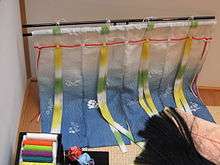Kichō

A kichō (几帳) is a portable multi-paneled silk partition supported by a two-rod T-pole.[1] It came into use in aristocratic households during and following the Heian period in Japan[2] when it became a standard piece of furniture.[3] They are similar in appearance to noren.
The kichō is often placed just on the inside of bamboo blinds, forming a portable double privacy barrier to the outside of the house. They are also used as portable room dividers inside the house.[4] Today, they are most often used as decorations or to hide boxes or other unsightly messes in a home.
In former times, they would often be used to hide noble women from public eyes when they visited shrines or temples, and to provide additional privacy for the women at home.[5] Smaller versions called sashikichō (差几帳) were carried by the female attendants of a noble woman in order to hide her from public view while she traveled.
See also
References
- ↑ Ueda, Atsushi (1990). The Inner Harmony of the Japanese House. Stephen Suloway (translator). Kodansha International. pp. 66–67. ISBN 4-7700-2353-7.
- ↑ 几帳(きちょう) [Kichō] (in Japanese). 人形のこうげつTAKASAKI. Archived from the original on August 18, 2011. Retrieved August 18, 2011.
- ↑ Murasaki, Shikibu (October 11, 2001). "General Glossary". The Tale of Genji. Royall Tyler (translator). Viking Press. p. 1151. ISBN 0-670-03020-1.
- ↑ Frédéric, Louis (April 30, 2005). Japan Encyclopedia. Käthe Roth (translator). Belknap Press of Harvard University Press. p. 514. ISBN 0-674-01753-6. Retrieved August 18, 2011.
- ↑ Sei, Shōnagon (April 15, 1991). The Pillow Book of Sei Shōnagon. Ivan I. Morris (translator). Columbia University Press. p. 288. ISBN 0-231-07337-2.
External links
![]() Media related to Kichō at Wikimedia Commons
Media related to Kichō at Wikimedia Commons
- 彩る調度の品々 (Japanese)